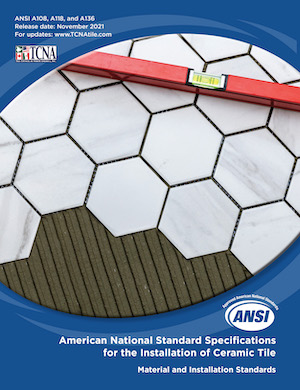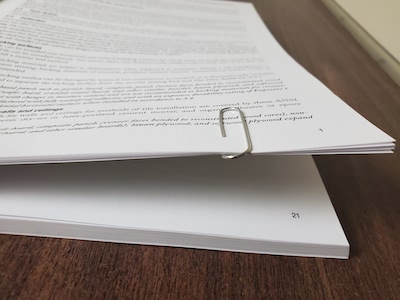
Many times, when we encounter something that has been in place as long as we can remember, we tend to accept it as is and continue using it. Such is the case of the American National Standards Institute (ANSI) A108.01 and A108.02 documents. Since some of the ANSI entries span several decades, the need for updating was necessary.
For now, the current A108/A118/A136 document is still in force and what is discussed here may/will not be implemented until the final revision is accepted by the full ANSI committee and printed.
The effort to update this ANSI document is not new. It actually began, in earnest, in May of 2017. Since then, many long hours and significant effort went into getting updates on paper. For various reasons, two earlier efforts since 2017, although well-intentioned, were not successful.
A renewed initiative began in the spring of 2020 which was explained through a letter to the A108 committee from ANSI A108 Chairperson, Chris Walker which is excerpted here:
“Some time ago we embarked on the task of reviewing the ANSI A108 and A118 documents. The goals were to improve consistency in terminology, recognize the changes occurring in modern construction and address the complex nature of multi-layer tile assemblies with tile module dimensions that seem to continue growing. We evaluated if information needed to be relocated within the document or if it needed to be removed if it was outdated.”
“You may have discovered inconsistencies when using the ANSI standards. If existing A108 language is unclear, out of date, or difficult to interpret, it is the intent of this review to eliminate inconsistencies and provide clear instructions, definitions, or information required to build reliable tile assemblies using previously approved and balloted methods and materials.”
“Many of the ANSI A108 Tile Installation Standards were developed more than 60 years ago and remain relevant today. They have been the foundation for successful installations for decades. However, changes are coming rapidly to our industry. As tile assemblies become more complicated, tile modules continue to grow and construction and installation techniques evolve, the challenge of providing successful installations has become more technically demanding and may require relatively technical solutions that address modern challenges.”
From these statements, you can see how complicated the rewriting process could be. A bystander might ask the question, “How long can it take to rewrite such a small part of the ANSI book?” This is a fair question. The two sections, A108.01 and A108.02, currently cover a total of 21 pages.
In response to the Chairperson’s letter, the A108 committee formed a subcommittee to undertake the rewriting task by calling a group of 15 interested tile folks to complete the new document. This committee met every other week via Zoom for several hours for approximately 22 months during the COVID-19 pandemic.
Becky Serbin, Education and Curriculum Director for the National Tile Contractors Association (NTCA) was designated as the person to maintain the working copy of the process as well as keep the subcommittee on task. She stated, “Honestly, when I was asked to help with this process and heard the scope of work, I really didn’t know if we would ever get as far as we did. After all, we were talking about basically re-writing industry standards and aligning them with installation practices of yesterday and today. And this isn’t just reviewing ANSI A108.01 and A108.02. Once those were reviewed, we had to take a look at all of the other standards that could be affected.”


During the initial review, the committee determined that A108.01 General Requirements: Subsurfaces and Preparations by Other Trades and A108.02 General Requirements: Materials, Environmental, and Workmanship had become blurred from their original intent. Over the years of updating that took place during scheduled ANSI meetings, a significant number of items of similar nature were listed in both sections, which confused the end user. It was decided that the documents would be separated into two categories of “Work by Others” and “Work by the Installer.” This change started the daunting task of moving, merging, changing, rewriting, and sometimes, deleting obsolete items.
When the committee dug into the existing text, it became apparent that some of the items really didn’t fit cohesively into the new .01 and .02 formats. In reviewing A108.02, the headers listed under Section 1.1 “Standards” and Section 3.0 “Materials” didn’t meet the needs of Work by the Installer. Both of these sections were included in a newly-created category known as “A108M Materials.”
Defining the terms
Additionally, many of the terms regularly used within the standard had never been defined, leaving the meaning up to the interpretation of the reader. It was a monumental job to first determine which words would be included, and then develop a definition. Had this work been added to the overall task, it would knowingly slow the committee’s progress. To tackle the creation of the new A108T “Terms” section, a hard-working subcommittee from within the working group worked double time to get it done.
In addition, a decision needed to be made as to which terms within the body of the standard would be used. Currently, the document has a number of descriptors which seem to mean the same thing, but there is no consistency. Which one would be the best fit? For example, what would be the best word to describe the area over which tile is to be installed? The list included; backer, backing, backing surface, backing materials, substrate, and surfaces. The final decision was to select substrate.
The work of the committee concluded with a review by the Tile Council of North America (TCNA) staff in February of 2022, making the project ready to be balloted by the full committee. The committee vote resulted in some expected negative votes which are in the process of being resolved. Once completed, the submission will be sent out for the next full committee vote.
Becky Serbin made these closing statements: “I want to thank everyone who volunteered their time to meet with this group every other week for at least a couple of hours at a time to review, rewrite, and, at times, have some heated discussions, on what should be in a standard and who should be responsible for the work…While there is always work needed with standards because technology changes or new products are developed, I hope that these changes will benefit the whole industry moving forward.”
Chris Walker added his closing comments: “I want to thank Becky Serbin. This has required monumental coordination and few people could have keep the level of detail and information as well as Becky has so far. Scott Carothers also has been instrumental in providing support as part of the NTCA team. Many others, too many to mention, have spent hours reviewing and discussing these changes. Our thanks should go out to all of them.”


Scott Carothers
Scott Carothers is the Acdemic Director for the Ceramic Tile Education Foundation (CTEF) and is responsible for the creation of the Certified Tile Installer (CTI) program, and is involved in the creation of the Advanced Certifications for Tile Installers (ACT) program as well as providing training to others in the tile industry.
Carothers has been involved in the ceramic tile industry for nearly 40 years and was the owner of a successful retail and installation firm prior to CTEF. He has served as President and Chairman of the Board of the National Tile Contractors Association (NTCA), Chairman of the NTCA Technical Committee, was named the NTCA Tile Person of the Year in 2005, and the NTCA Ring of Honor recipient in 2013. He is a voting member of the ANSI and the TCNA Handbook committees.







